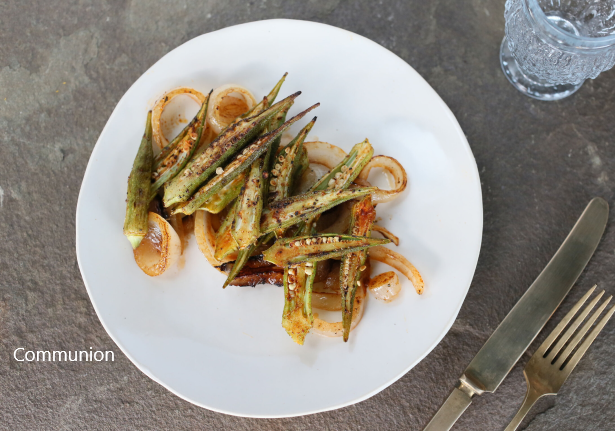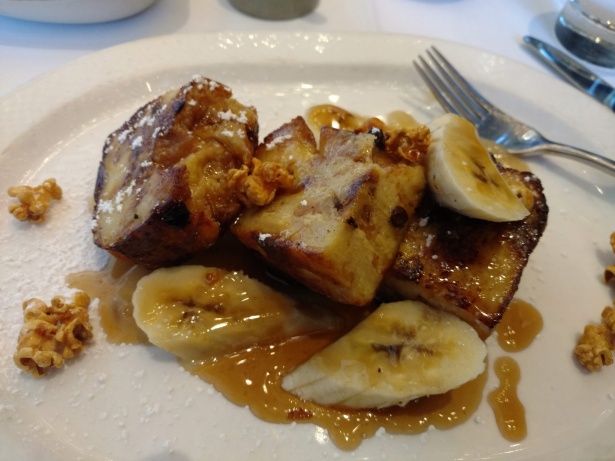QT 109 – The Best and the Brightest

Why hello there! Thank you all for bearing with us these past couple weeks. On top of the chicken nursing and passing, last week had a very fun “Wednesday, Jon went to see a neurologist, who diagnosed him with migraines, and prescribed him with medication he didn’t have time to pick up” followed by “Jon woke up Thursday with a Migraine.” So this is a Thursday post that was intended for LAST week, coming to you now. Left-over literature. But I for one am grateful for the time, because it let me mentally tumble my idea for the post around to try and get some of the jagged edges off. And to explain why, let’s talk about some cool news I heard about Communion recently.
Mr Not-So-Worldwide
Fun fact: did you know that Catholic MEANS “universal”? It comes from the Greek Kataholos, and later Katholikos, for “respecting of (the whole/entirety)”. It’s the Catholic Church because it’s the “worldwide church”. (And later to distinguish itself from regional variants or heresies: “they have their local falsehoods, but we have the universal truth.”). And it’s an interesting confluence with the topic of today’s post, because I didn’t mean Catholic Communion, but rather Communion, Seattle.
Which is a far more flavorful form of communion.
Communion is a new Soul Food restaurant in Seattle that made headlines recently, being recognized as one of the 12 Best New Restaurants in the World by Conde Nast Traveller. Conde Nast, if you don’t know, is the conglomerate that owns GQ, Vanity Fair, Bon Appetit, The New Yorker, Vogue and its far more politically challenging Teen Vogue, and several other outlets.
And that’s rad! It’s great to hear American Soul Food, an oft-overlooked and underappreciated food style (as many ‘cuisines of the common man’ are underappreciated), and I’ve definitely put in on my “list of restaurants in Seattle to try and convince my family to go to”. Though, given the success rate on moving through that list, who knows if that will come to anything: At least two restaurants I put on the list shut down before I got to them, and one has specifically been “mom and I just need to take Nate to this place we both went to before and therefore know we like” for THREE AND A HALF YEARS.
For context on how long it’s been: I called in February 2020 to see if I could put together a (several months late) Birthday brunch at the place, and the person who answered my call was confused, because they haven’t SOLD brunch in 3 years.
I particularly want to highlight that the business is Black-family-owned, and is located in the Liberty Bank Building, which was the first Black-owned bank in the Pacific Northwest, which specifically was created to fight redlining in the region. That’s an amazing pedigree and set-up, and I hope to hear of tons of success for them in the future, especially given this prestigious acknowledgment. Hell, I am directly interested in MULTIPLE items on their menu, and hope to try their food soon.
I want that all out in the open, because the next portion of the post might come across as if I’m diminishing their success and this acknowledgment, and I don’t want that to be the take-away. I am excited for Communion. I am grateful to have been made aware of it, and IAnd it’s that acknowledgement I ALSO want to talk about. Because what I found struck me about this award was a sense of “Who?”
Be Zen or Best Ten?
Like, listen, I’m the foodie guy. I know PLENTY of ranking organizations. Yelp, TripAdvisor, Google Reviews. In more formal settings, Bon Appetit, a magazine I noted is also owned by Conde Nast, has an annual “best restaurants of the year” issue. There’s the “50 Best Restaurants in the World” list, which was created by a British media group, and the Michelin Stars guide, which, as many online have noted, yes, does come from the tire company.
Amazingly? The Michelin Man actually predates the Michelin Stars system.
Different bodies will have different criteria, sometimes fair, sometimes less so. The “50 Best Restaurants in the World” list, for instance, takes its system VERY seriously: it uses a group of 1,040 restaurateurs, travel guide writers, food critics and other industry professionals, a group it is constantly cycling through year-to-year, while seeking to maintain a constant gender balance, and a diverse representation of precise regions, with voters having to select at least 4 of their 10 picks from outside their region. Just reading all the effort they put in to at least SEEMING fair is impressive. And even THEN, there is opportunity for bias: the voters are selected by chairpersons from each of the 26 regions, who pick 40 voters from their region to be in the pool…meaning that if the chairperson doesn’t like certain restaurants and styles, they can pick voters they think won’t back those things. And one of the reasons for those rigid standards is due to past criticism of lacking female representation and being too Eurocentric in its picks. Some view the entire enterprise as a kind of counter-argument to the Michelin system.
Fun fact about that system: how did a tire (or tyre, as they would say) company become the standard for culinary excellence? Well, the answer to that is Money, my dear boy. Michelin back in the 1900’s (as in, ‘the decade before the 1910’s, not “any year starting in 19”) wanted to increase demand for cars, and therefore their tires. So they put together what was essentially a map of potential road trip ideas for France: “Here’s some popular routes people use, and some reliable mechanics, good hotels, and nice restaurants along each of them.” The Parisian gentleman could learn of the luxury of Vichy, or the stunning cathedral of Bourge, and learn that they could be at those places within a DAY by a good automobile, with a night over in a fine hotel. A fine weekend trip…if you owned a car.
In the 20’s, they added the “Star” signifier to detail a restaurant that was especially lovely to visit if possible, expanding to the 3 star system in the 30’s: one star meant it was an exceptional restaurant; two stars meant it was so good that if you were planning a trip NEAR it, you should think of making a detour; and three meant a restaurant so good that it was worth a road trip on its own. Because, again, the point was to sell tires.
“What a beautiful cathedral this is, no? Perhaps you should drive 6 hours to see it, and then another hour to a lovely little mountain-top chateau.”
I bring that up in particular (we’ll likely do a deeper dive on the system at some point) to highlight the kind of biases that can drive certain picks. Do we KNOW that Michelin guides put in extra attention on places that were harder to reach by public transit or bicycle? Favoring the more remote fine dining over centrally located establishments? No. But knowing the goal of the system, it feels pretty believable, right?
And those kind of biases, and specific preferences, are everywhere. They riddle everything. My mother doesn’t like onions. I don’t like seafood. Nate can’t stand cilantro. Nate likes direct trips with clear objectives, while I struggle to motivate myself to do simple trips because I don’t see the pay-off as worth the effort. All of us will pick different trips, and hotels, and restaurants if given power to do so. Just because someone has glossy pictures and a magazine behind their argument doesn’t mean you HAVE to enjoy the food they recommend, or that, necessarily, the food you love isn’t fine.
Are there more authentically Korean places than Mina’s Cafe in my hometown? Probably. Would they sell me loco moco and gyoza? Probably not, and I don’t think that’s an entirely justifiable trade-off.
There’s a Zen koan that I particularly like, about food. Koans are like riddles or parables meant to help/check people’s progress in the path of Zen Buddhism. The one I like is about Banzan the monk and the butcher: a notable figure was visiting the monastery Banzan studied at, and the abbot sent him to the market with express instructions to find “the best meat for the guest’s meal.” Banzan arrived at a butcher’s shop, and beheld the wide variety of meat available: pork and beef and chicken and duck, wings and short ribs, roasts and sausages. And he asked the butcher “excuse me, but which of these meats is the best?” And the butcher responded “All my meats are the best. There is no meat here that is not the best.” And at these words, Banzan became enlightened.
The standard interpretation of the koan is that the obvious falsehood of the claim reveals the lie of “best” more broadly: To be ‘best’ is to be above all others. Therefore, there cannot be a shop FULL of “bests”. By realizing that the butcher was lying about his meat, Banzan realized that there is no “best” or “worst” meat, only the meat there is.
Like, On the one hand, I know this is an amazingly marbled wagyu steak. On the other hand, if I DIDN’T know that pedigree, it would look grey and frost-bitten to me.
My point being: it’s good to have your own opinions about food. You can try places that people recommend to you, or that you see getting awards like this, and if you like them, great! But maybe you won’t like them. Maybe you’re not in a place to understand what they’re trying for, or you have an intolerance or sensitivity that will stop you from loving them, or the place was having a bad day. It’s one of the reasons I’ve personally always felt weird about potentially ‘reviewing’ restaurants: when you come and who you are when you do so can change so much.
Thus, you can read that Communion was ranked “one of the 12 best new restaurants in the world”, and you can go, and not love it, and that’s fine. You can read that a soul food restaurant made the list, and say “You know, I don’t eat much soul food, I should try some in my area”. You can read the list, announce “who cares?” and go back to eating what you love. All are valid. (And most of them mean you won’t be competing with me for a reservation, so please, feel free to remove yourself from my way.)
MONDAY: IS MEMORIAL DAY, SO WE WON’T POST. HOWEVER…
NEXT THURSDAY: MEMORIAL DAY IS WIDELY CONSIDERED THE START OF GRILLING SEASON. SO I MIGHT HAMMER OUT A COUPLE BURGER TOPPINGS, AND TALK ABOUT BUILDING BURGERS. (I might also put this up on like, Wednesday, as I have a trip on Thursday.)











